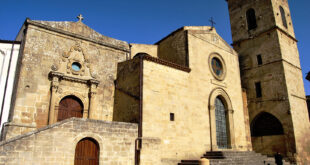 Assoro è ricca di mito e di storia: si dice infatti che fosse assorina la Ninfa, madre di Dafni, il dio musico e poeta al quale si deve la poesia bucolica.
Assoro è ricca di mito e di storia: si dice infatti che fosse assorina la Ninfa, madre di Dafni, il dio musico e poeta al quale si deve la poesia bucolica.
Cicerone (1° Sec. a.C.) definì la città “balcone centrale della Sicilia” e quasi senza respiro – per la sua bellezza – lascia il panorama, fatto di ampie distese di grano e di uliveti secolari, che si ammira da piazza Umberto.
Un autentico gioiello di architettura può poi definirsi la Basilica di S. Leone, che riesce ad attirare l’attenzione anche del visitatore più superficiale, sia per la sua struttura, sia per la magnifica “Conca” del Gagini, sia per un crocifisso di scuola gaginiana, una Croce processionale del 500 ed artistiche statue in legno dorato.
An old popular saying, indicating the ancient origins of Assoro, links the birth of the town to a period preceding that of Rome. The saying comes to life in the testimonies which history has left all over the territory of Assoro; testimonies which have unfortunately become the prerogative of thieves in the numerous archaeological sites in the town. In more recent times, Assoro continued to give prestige to its history by becoming the possible birthplace of a pope and certainly of a minister from the kingdom of Italy. Up until a few decades ago, when the sulphur mines were among the most productive. You can reach Assoro from the ringroad of Leonforte, three kilometres away. A private church bell-tower welcomes you at the entrance of the town. A sign, as it were, of a past which has seen the construction of numerous churches in the area of Assoro. Today only a few of them remain. Among the more beautiful one’s is the main church dedicated to St. Leone II. The scarce interior light renders the atmosphere created by the twinsted pillars, flaked off over the centuries, the 16th century baptismal font, several wooden statues, a 15th century silver cross and enamelware width gold decorations, even more mystical. Among the monuments worth visiting, do not miss the ruins of the castle (nowadays part of an urban park) and the baronial palace of the Valguarnera family. For those who like walking, there are the narrow and impassable streets in the old town centre, which branch off from via Balzo and lead to what remains of the numerous churches which were once scattered all over the town.
The first foundation stone of Assoro’s big church was laid during the XII century in S.Lion’s honour; then it was rebuilt during the XV century. This worship place suffered different remaking in the following centuries, among which the rebuilding of the front in the eighteenth century with a portal in gothic catalan style. The inside is divided into three aisles of baroque style which support pointed archs of gothic style , the crucifix painted upon both the faces, of the fifteenth century is leaning from the wooden beam ceiling lacunar of the sixteenth century . From that period we found the marble altar-piece in the apse, the font and the six wooden statues of the Saints. Upon a fascinating cross, fused in siver with bass-relief in gold by Vincenzo Archifal in the sixteenth century, preserved in the sacristy, appear the crucified Christ’s and rised Christs faces.
 EnnaVivi Magazine della provincia di Enna
EnnaVivi Magazine della provincia di Enna



